Welcome to our in-depth analysis of HyImpulse Technologies, originally published December 15th, 2022 and most recently updated in March 2024 (highlighted in blue). Make sure to check out our mission statement and why we do what we do. Look at our New Space guide if you want explanations of terms and concepts used in our research. And follow us on Twitter for updates.
What you should know about HyImpulse Technologies GmbH
📰 For space enthusiasts
- Developing 3-stage “SL1” hybrid rocket based on LOX/Paraffin propulsion
- Mini launcher with max LEO capacity of 500 kg
- SL1 launch vehicle: 8×75 kN HyPLOX75 1st stage, 4×100 kN HyPLOX75 2nd stage, 4×25 kn hybrid engine cluster 3rd stage based on HyPLOX10
- First suborbital launch of SR75 planned for 2024 from Southern launch. Orbital launch earliest 2025 from SaxaVord
- Technology proven through sounding rocket (research rocket) launch with 32 km apogee test flight in 2020
- Iterative and highly research-based approach
💰 For VCs and industry experts
- Founder-led, small scale rocket launch company spun off from students working on hybrid engines at University of Stuttgart and at the German Aerospace Center (DLR).
- Received significant EU and government research grants totaling > EUR 5 million
- Sole investor and controlled via Schwarz Holding GmbH by Rudolf Schwarz, CEO of IABG, a German manufacturing company with >1,000 employees, who’s invested at least EUR 5 million into the company
- Long-term goal of conducting 30 – 50 launches per year by 2030 with a payload capacity of 500 kg to low Earth orbit. Price-tag at EUR 15,000/kg by 2030.
👨💻 For potential employees
- Stable employee size with currently around 55 employees
- Unique technology approach in niche: hybrid engines
- Sourcing highly specified employees with only few open positions
- Close to DLR (German Aerospace Center) in practice and geography

HyImpulse: German new-space company building mini-launcher with hybrid motors
HyImpulse is a rocket launch company based in a small village in southwestern Germany. It was founded in 2018 as a spin-off from 4 students by University of Stuttgart who worked on hybrid motors at the DLR (German Aerospace Center). The company is developing a unique hybrid propulsion system using paraffin (candle wax) as the propellant and oxygen as the oxidizer.
One of the things that sets HyImpulse apart – apart from its hybrid motor – is its history of successful small-scale rocket launches, including the world record for a hybrid rocket in 2016 and its 75 kN SR (“Sounding Rocket”) test vehicle, which reached an apogee of 32 km in 2020. The company’s future launch vehicle, the three-stage SL1 (“Small Launcher 1”) is designed to provide up to 500 kg of payload to low Earth orbit for commercial and governmental customers, with launches originally scheduled to begin in 2024, but now expected earliest 2025.
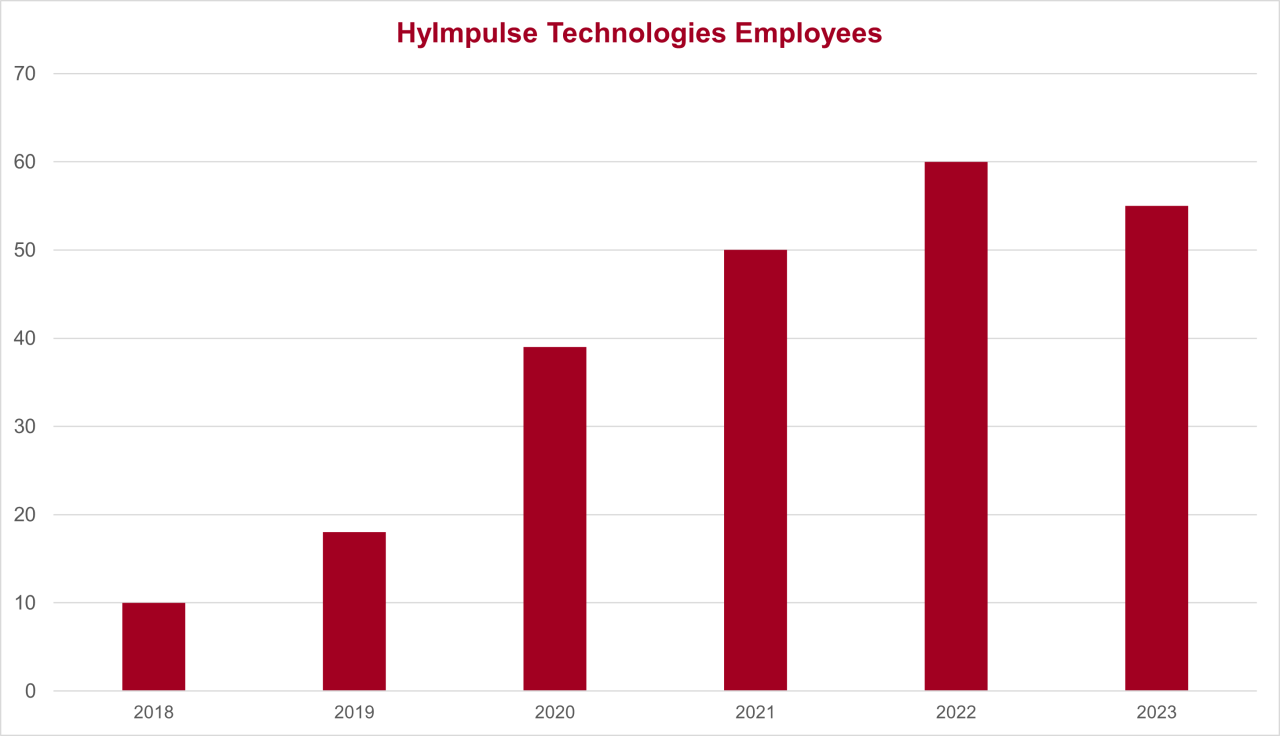
HyImpulse is very research-driven and has close ties to several universities, the DLR and other governmental and research entities, having received part of its funding from government grants as well as from its sole and controlling investor, Schwarz Holding GmbH, itself related to a German manufacturing business (IABG) based on the outskirts of Munich, in Ottobrun.
The company’s goals in terms of payload are rather modest compared to its German competitors such as Isar Aerospace and Rocket Factory Augsburg. HI’s launch vehicle is capped at roughly 500 kilograms of payload, whereas both Isar and RFA have vehicles of at least 1 metric ton. HyImpulse’s originals plans were to scale to 6 flights per year in the second year and up to 50 launches per year by 2030. While the hybrid motor technology is quite unique, it will not be reusable and have an initial price tag of around $20,000 per kg and a long-term goal of around $15,000 kg by 2030.
Launch location: UK or Australia? The back and forth
HyImpulse has been in contact with all the premier European launch destinations, apart from Kourou, since 2021. Since then, they’ve narrowed down the choice contractually to three locations:
- SaxaVord in the Shetland Islands (launches)
- Southern Launch in Australia (test launches)
- German Offshore Spaceport Alliance (letter of intent, test launches?)
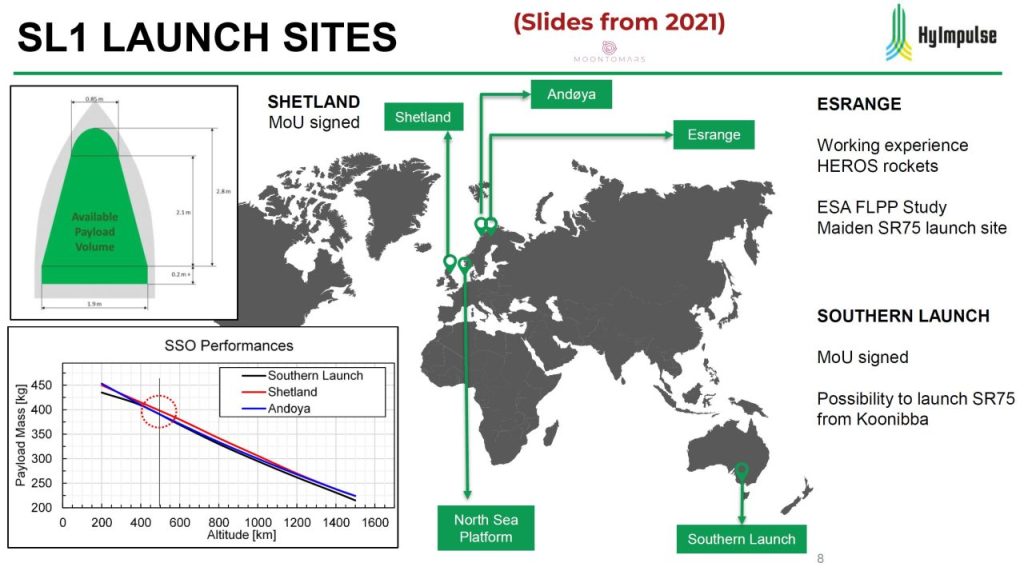
There are now contracts in place with SaxaVord Spaceport in Scotland, where the SR75 was tested and qualified. Up until mid 2023 SaxaVord seemed to be the primary destination for HyImpulse. However, in November 2023, HyImpulse announced a partnership with Australia’s Southern Launch, just one day before confirming their partnership with SaxaVord in a press release. While there are no public statements from either company, we assume that SaxaVord’s delayed construction – mostly associate with business and financial uncertainty rather than technical issues – brought on the partnership with Southern Launch. The initial launch of the smaller SR75 rocket is now planned from Southern Launch in Australia in Q2 2024.
The fact that HyImpulse is sending its rocket on a journey halfway around the globe and undergo another certification (with the help of Southern Launch), rather than partnering with Andoya Space or the Swedish ESRANGE doesn’t bode too well for the European spaceports or the friendliness of EU launch licenses. The launch company also has a signed letter of intent with the German Offshore Spaceport Alliance, who were planning their first suborbital test-launches in Q2 2024.
HyImpulse’s unique and technology proven hybrid rocket motor
The story that lead to the founding of HyImpulse
HyImpulse Technologies GmbH was founded in 2018, but its beginnings date back over 15 years. Initially a student initiative launched in 2006 called “HyEnD” at the University of Stuttgart, HyEnD started developing and testing hybrid engines which lead to research initiation at the DLR Institute of Space Propulsion in Lampoldshausen. Their efforts paid off, with successful launches in 2015 and 2016, including the world record launch of HEROS3 with an altitude of 32.3 km. This led to the conceptualization of a small launch vehicle based on hybrid engines and the founding of HyImpulse Technologies GmbH in 2018 by 4 engineers, Christian Schmierer, Ulrich Fischer, Dr. Mario Kobald and Konstantin Tomilin. The HyImpulse Holding GmbH, which is the main shareholder of the HyImpulse Technologies GmbH also includes Prof. Dr. Stefan Schlechtriem, who heads the DLR Institute of Space Propulsion.
Building a test vehicle (SR10, SR75) and the SL1 hybrid rocket
After the successful launch of their sounding rocket test vehicle, HyImpule’s team began developing the HyPLOX 10 engine further (HyPLOX10 stands for Hybrid Paraffin Liquid Oxygen with 10 Kilonewton of thrust). This development was followed by more research into small scale Carbon Fiber Composites (CFRP) hybrid rocket engines and the beginning of the test campaign for the 75 kN hybrid engine called HyPLOX75, to be used on the SR75 test vehicle. The HyPLOX75 will be the main “work horse” of HyImpulse’s launch vehicle, the SL1.
The SL1 will be a three-stage vehicle, 27 meters in height, 2.2 meters diameter with a lift-off weight of 36,000 kg. The composition in detail:
- First Stage: 8x HyPLOX75 motors, 5 tons of paraffin, CFRP LOX tank with 12.300 litres, Gas Generator (GG) cycle with turbo pump, plus a helium tank to pressurize GG-fuel (ethanol) and LOX-tank
- Second Stage: 4x HyPLOX75 motors (capable of 100 kN due to higher expansion ratio), 2.5 tons of paraffin, same GG-cycle as first stage
- Third Stage: 4x HyPLOX25 motors (based on small scale technology demonstrator HyPLOX10 engine), 730 kg paraffin, 1.800 litres CFRP oxidizer tank, pressure-fed
The first stage will be “optionally recoverable” with parachutes/gliders, to be picked up and disassembled, with reusable components refurbished and reintroduced into HyImpulse’s supply. The full vehicle will weigh around 40 tons with a length of about 27 meters.
| Parameter | 1st Stage | 2nd Stage | 3rd Stage |
|---|---|---|---|
| Number of hybrid motors | 8 | 4 | 4 |
| Required combustion time (in s) | 100 – 120 | 50-80 | 100 – 120 |
| Average pressure (bar) | 60 | 60 | 11,5 |
| Expanse ratio | 16 | 41 | 30 |
| Average specific impulse (in s) | ~270 | ~321 | ~313 |
| Average sea-level (1st) / vacuum (2nd/3rd) thrust (kN) | ~650 | ~400 | ~100 |
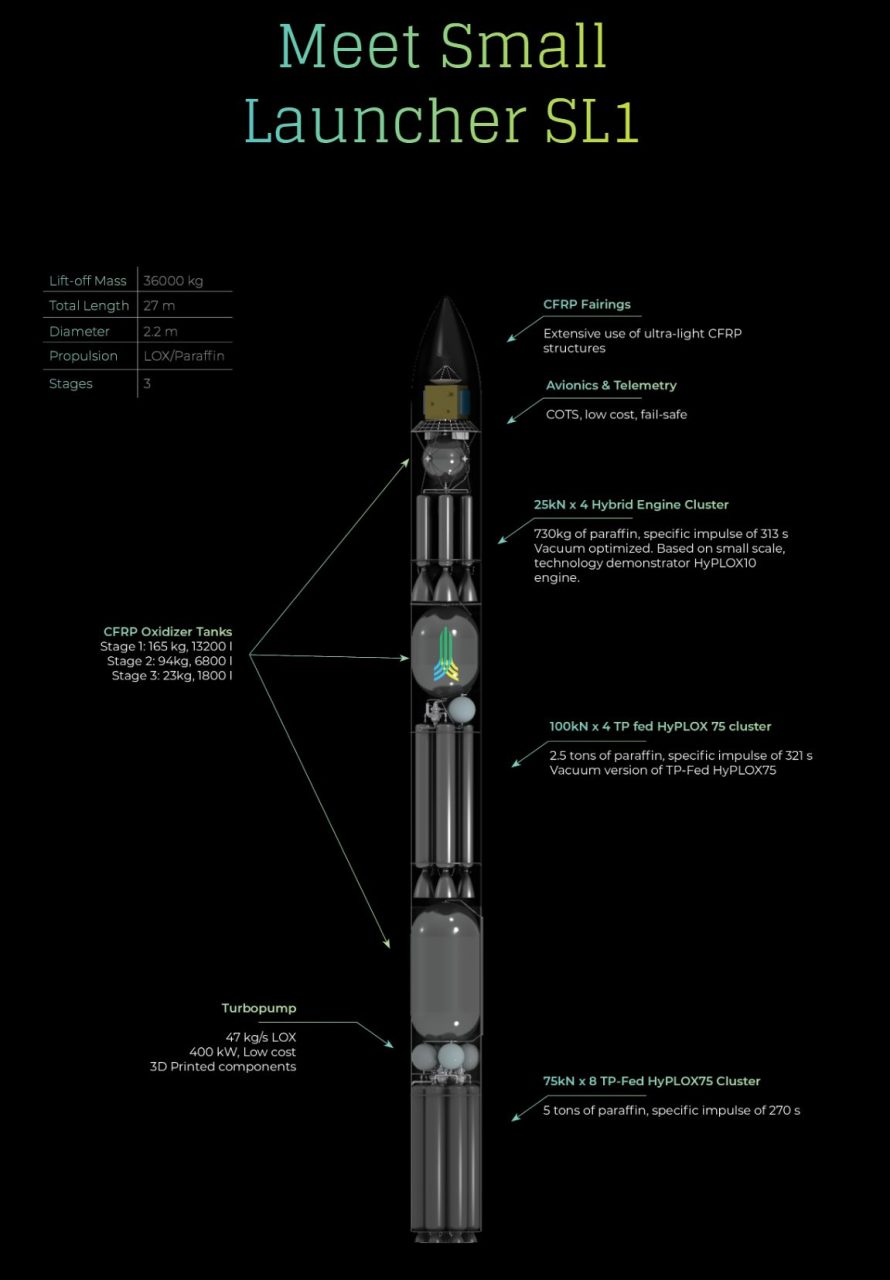
So far, HyImpulse has achieved several milestones in their development, including:
- Over 3 successful launches of their sounding rocket and over 500+ tests on technology demonstrators
- Moving to a 1000+ square meter facility in June 2020
- Successful test of full-scale flight rocket motor TRL 7 in Scotland in 2021
- Full wet-dress rehearsal of the SR75 in August 2022, as seen below
- Engine and rocket qualification of the SR75 for launch in September 2023
Currently, the maiden flight for the SR75 research rocket is planned for second quarter of 2024.
Intermission: A quick look at hybrid motors and how they compare to liquid and solid fuel rockets
What makes HyImpulse’s approach so different? There are basically three types of fuel rockets can use: Liquid, solid and hybrid.
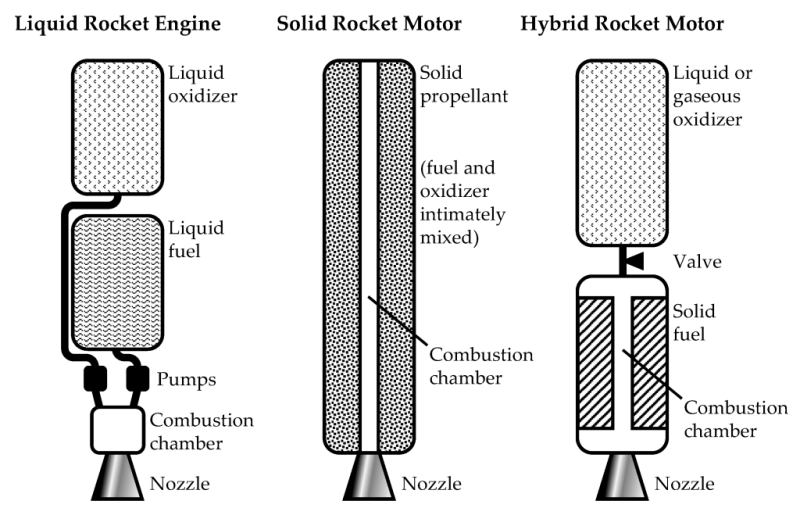
- Liquid fuel rockets (having “engines“) are the main choice for space-bound rockets and almost everyone uses it (SpaceX, NASA/US, Russia for the Soyuz, China for the Long March). This is because liquid fuel rockets have properties you want for launch rockets, such as high specific impulse, high efficiency, the ability to turn them off and on again etc. The downside of liquid fuel rockets is that they’re quite dangerous and engines tend to be rather complex.
- Solid fuel rockets (having “motors“) are mostly used for missiles used by the military, such as air-to-air missiles, short-to-mid range missiles and even ICBMs, though a few use liquid fuels. Solid fuel has low efficiency and lower specific impulse, but they still give good thrust and they’re pretty safe to handle. However, once you light a solid fuel rocket, it’s hard to turn them off – and forget about full reusability.
- Hybrid fuel rockets (having “motors“) have so far been primarily used for research, teaching and experimenting. They combine some of the advantages from solid and liquid rockets by using solid fuel and liquid oxidizers. You can therefore turn them off (and on) again, you can still get a pretty good specific impulse and they’re much safer to handle than liquid rockets. Unfortunately, hybrids still have several disadvantages: they require a fairly complex motor, expensive structures to handle temperatures (such as carbon composites), your ISP is never going to be as good as that of a liquid fuel rocket and full reusability is considered to be outright impossible.
Hybrid rockets offer an advantage over both solid and pressure-fed bi-propellant systems in certain situations. However, this advantage disappears when dealing with larger rockets or those used for orbital lift. Solids are generally better at scaling to high thrust levels because they can achieve high mass flow rates. This is because solids can be designed with a larger combustion chamber and the thrust is dictated by the propellant mix and chamber geometry, allowing for time-tuned thrust. However, solids have lower overall exhaust velocity and are typically used for short, high thrust burns. On the other hand, liquids have higher exit velocity but are limited by the flow rate of the system and the size of the combustion chamber.
Hybrid rockets combine some of the benefits of both solid and liquid rockets, with the ability to scale up like a solid and the throttle control of a liquid. They also have the advantage of a cleaner exhaust since they can use more environmentally friendly propellants.
Overview of hybrid rocket motors and hybrid engine new-space companies
| Company | Country | Payload | Fuel | Oxidizer |
|---|---|---|---|---|
| HyImpulse Technologies GmbH | Germany | 500 kg LEO | Paraffin-based | LOX |
| Nammo AS (Nordic Ammunition Company) | Norway | <150 kg LEO | HTPB | H2O2 |
| Virgin Galactic LLC (formerly The Spaceship Company) | USA / UK | Suborbital manned | Polyamide | N2O |
| TiSPACE INC | Taiwan | 300 kg LEO | HTPB | N2O |
| Gilmour Space Technologies Pty. Ltd. | Australia | 300 kg LEO | 3D-printed fuel | H2O2 |
| Vaya Space Inc. (formerly Rocket Crafters) | USA | 1000 kg LEO | 3D-printed ABS | N2O |
| T4I Technology for Propulsion and Innovation SPA | Italy | Orbital propulsion | Paraffin-based | H2O2 |
| Space Forest Sp z o.o. | Poland | Orbital propulsion | Paraffin-based | N2O |
| Equatorial Space Ltd. | Singapore | 65 kg LEO | Paraffin-based | LOX |
HyImpulse’s hybrid fuel rocket and what they do differently
HyImpulse uses a hybrid motor with paraffin (wax) and oxygen, which are both cheap and safe to handle by space standards, and the design of the rocket structure is simple and suitable for mass production. Typically, complex cast profiles are required in solid fuel motors to increase the surface area for burning. This is not necessary with wax because, like a candle, drops detach and the wax burns on its own.
Unlike the structure however, the physics of the motor are not quite as simple. For example, HyImpulse engineers are developing vortex generators to properly mix the wax and the passing oxygen. Temperatures can also be tricky. HyImpulse is looking for a fiber composite construction for the combustion chamber that can withstand the thermal load for the duration of the burn. For fuel, HyImpulse uses a paraffin based version, which was chosen in part since it is affordable, low-toxic and offers faster regression rates than traditional polymeric fuels.
HyImpulse: Funding, valuation and business model
HyImpulse funding rounds and financing
Since there are no large public funding rounds done through VCs or similar, we had to look a bit deeper. Currently, the company has 33,329 shares, of which 25,000 shares (75.01%) are held by HyImpulse Holding GmbH, which in turn was founded by the four engineers running HyImpulse and a DLR member. The 8,329 outstanding shares are held by Schwarz Holding GmbH, which is an investment vehicle of Prof. Dr. Rudolf Schwarz, who is in turn CEO and main shareholder of IABG, which is a test- and engineering company based in Munich. HyImpulse also shares an address with IABG.
Though the founders of HyImpulse have technically more than 75% of the shares, Schwarz exerts major control through several veto-rights according to the company’s statutes, such as for any sort of funding round, liquidation, appointing directors, approval of the annual report and more. HyImpulse is also listed as an associated company by Schwarz Holding GmbH’s annual report.
What’s furthermore atypical for a startup is that Schwarz has taken on a double position of equity-holder – with all the rights a shareholder has in the German vehicle of a “GmbH” – while giving debt instead of equity to the company. At the end of 2021, the company had over 6 million Euro in liabilities through loans from Schwarz, with 2 million (2020: only 300,000,- Euros) in equity paid in. Schwarz has done at least two further capital raises in November 2021 and October 2022. The funding round in October 2022 seems peculiar, since HyImpulse was planning on raising a larger Series A in 2022 and has announced in 2021 and at the beginning of 2022 that they wanted to scale to 100 employees. So far, both goals have apparently not come to fruition and the company will seek a rocket qualification on a smaller scale.
Another interesting development is the UK/ESA Boost! funding over almost GBP 3.5 million in December 2023. While announced, it seemed like the grant was coming with a strong UK backing for HyImpulse’s launch activities in Shetland. However, the money, or at least parts of it, will be flowing to a new UK-based joint venture between 49% HyImpulse Ltd. (the UK subsidiary) and 51% Adamant Composities, a Greek company. The new JV, Carbon Launch Systems Ltd., was set up solely for the purpose of receiving ESA grants and is supposed to help develop the carbon-fibre reinforced plastic tanks.
Major financing operations done by HyImpulse
| Date | Shares | Funding |
|---|---|---|
| March 2018 | 25,000 | Founding of the company |
| November 2018 | 25,639 | Funding round, amount unknown, included EUR 2,500,000 (debt, estimate) |
| November 2019 | EUR 2,500,000 from EU (grant) | |
| November 2020 | EUR 500,000 from ESA (grant) | |
| December 2020 | EUR 1,500,000 (debt, estimate) | |
| March 2021 | EUR 175,000 from EU (grant) | |
| November 2021 | 30,147 | Funding round, amount unknown |
| October 2022 | 33,329 | Funding round, amount unknown |
| November 2022 | EUR 1,000,000 from state (grant, estimate) | |
| December 2022 | EUR 500,000 from UK (grant) | |
| December 2023 | GBP 3,500,000 grant via ESA-boost. |
HyImpulse valuation – estimated between 25 and 40 million Euros
With an atypical funding structure for a launch startup and lack of public information, it is hard to give a proper valuation to HyImpulse. Generally, going by benchmarks from their technology to the company- and employee-size to potential revenue streams through their launches, we estimate the company to be valued somewhere between 25 and 40 million Euros.
We assume this valuation based on public (debt) funding through their investor Schwarz Holding, who’s given at least EUR 6.5 million to the company up until December 2021. Since then, a lot of progress has been made with their SL1 rocket and employee count has risen to around 60 – albeit remaining stagnant for most of the last 12 months, while also having pushed back their initial launch of the SL1 from 2022 all the way to 2025.
Going by (potential) revenue, a single launch yields between EUR 6 million to EUR 10 million if successful (assuming a payload of 300 – 500 kg at a EUR 20,000 price tag), with further growth the following years.
Going by funding needs, HyImpulse’s management has said that they need at least EUR 25 million to launch their first rocket, with at least EUR 100 million to make the business scalable. So far, we believe they have received around EUR 15 – 30 million in total funding and grants.
HyImpulse Technology’s business model and strategy: A few considerations
The business model of HyImpulse seems straightforward:
- Develop a mini-launcher capable of bringing up to 500 kg to LEO.
- Target specific niches where your advantages help, such as low lead-time from contract signing to launch, flexible scheduling, individual orbits.
- Scale the operation.
However, going with a hybrid rocket – a decision the founders implicitly took in 2008 when they started to experiment with hybrid motors and built up their knowledge – has put HyImpulse into a smaller niche. It seems the first stage might be refurbishable to some extent. While there are different projections on the cost per kilogram of the vehicle, the overall trend has been going up slightly: In 2020, costs were projected to be at $13,000 per kg initially and $8,000 per kg once rocket motors are serially produced, statements made in 2020 have been closer to $20,000 per kg in 2023 and $15,000 per kg in 2030. In 2021 the company estimated EUR 16,000 initially and EUR 7,000 by 2030 with around 30 launches per year.
Our opinion on HyImpulse Technology and their hybrid rocket
What we like about HyImpulse
- They’ve actually sent stuff to space: HyImpulse is generally very iterative and relatively transparent, they have frequent (and public) test launches and give insights into the company, the engine tests and rocket launches – something other companies tend to avoid all-too-often.
- Publicly available research: HyImpule’s developments have been very consistent over the years and we applaud the very public approach which yields lots of published research, see for example here, here, here or here.
- Reminds me of the old German ways: Keep your head down, work on engineering problems, no big numbers, no flashy PR. If this were the 90s, I would say HyImpulse is a great example of “German Engineering” (except for the punctuality…)
What we don’t like about HyImpulse
- Greenwashing: Waving the wand of sustainability still attracts press, public figures and government grants particularly in the EU, even when it is a subordinate concern to the actual cause, such as low emission propellants developed for expendable vehicles – similar to applauding CO2 savings for leaving off the A/C when driving a gas car.
Things to watch out for
- Funding: Space is hard, and it seems HyImpulse is getting closer to the “make or break”-mark for continued funding via the Schwarz Holding. The employee-count is stable (stagnant?) and there are no signs of an external funding round. The maiden launch of the SL1 was also postponed again, this time to 2025. With 55 (2023: 60) employees in at least two countries, HyImpulse is probably spending roughly EUR 300,000 – EUR 500,000 per month for employees alone – not including R&D and equipment.
- Business model: HyImpulse has significant technological knowledge, unique skills and proven assets. Hybrid motors are not just valid for launch vehicles on earth, but also on other planets or for in-orbit services. Furthermore, rocket engines and motors have significant applications in aerospace, defense and military, fields in which their main investor Schwarz Holding has expertise and interest. It will be interesting to watch HyImpulse’s development over the next 18 months.
Structured company information on HyImpulse Technologies GmbH
- Background Information
- Official Name
- HyImpulse Technologies GmbH
- Date founded
- March 2018
- Management
- Dr. Mario Kobald, Dr. Christian Schmierer
- Founding Investors
- HyImpulse Holding GmbH
- Official Name
- Locations
- Wilhelm-Maybach-Straße 5, 74196 Neuenstadt am Kocher (Headquarter)
- St. Olaf’s Hall, Church Road, Lerwick, Shetland Isles, ZE1 0FD (Subsidiary, Launch Site)
- Lampoldshausen, Germany (DLR Test-Site)
- c/o DLR e.V., Im langen Grund, 74239 Hardthausen (former headquarter)
- Subsidiaries / Joint Ventures:
- UK-based Carbon Launch Systems Ltd. with Adamant Composites
- Contact
- contact@hyimpulse.de
- https://hyimpulse.de/en/
- HyImpulse Twitter
- HyImpulse LinkedIn
- HyImpulse Facebook
- HyImpulse Youtube

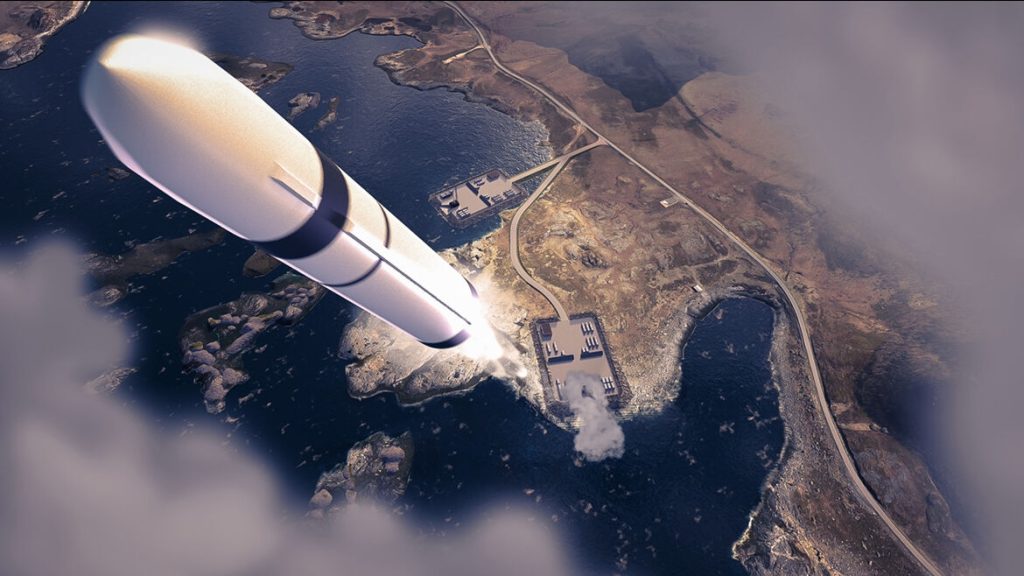

Outstanding analysis! Thank you for sharing.
Good analysis except for the info of the 2020 launch of a sounding rocket. That didn’t happen. So far the last launch of the team was the HEROS3 rocket in 2016 when they were still part of the student group HyEnD. Until now, the following generation of HyEnD students has managed to double up on that record.